Consumer Electronics Show 2005: AT's Coverage
by Anand Lal Shimpi on January 10, 2005 3:49 AM EST- Posted in
- Trade Shows
Transmeta Demos 90nm Efficeon at 2.0GHz
Despite the negative news reports regarding Transmeta in the mainstream media, the unique chip manufacturer actually had a more interesting (from a PC perspective) booth than AMD.
The most impressive demonstration at Transmeta was of a 2.0GHz, 25W, 90nm Efficeon. The clock speed alone was impressive, considering that the fastest Efficeon demo we'd seen previously was at 1.6GHz. The other part of the demo that was impressive was the test itself: a 6Mbit WMV HD playback test with no GPU assistance.
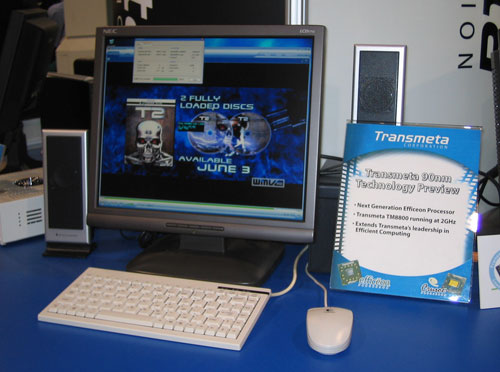
WMV HD (1080p) playback is one of the most stressful playback tests you can run on a PC, and the fact that the Efficeon is able to handle it is a huge feather in Transmeta's cap.
The demo also monitored clock speed, which ranged from 1.2GHz up to 2.0GHz, with the majority of the playback happening with the CPU at 1.4/1.6GHz. While 1.6GHz Efficeon products are available today, 2.0GHz offerings should be hitting the streets before the end of the year. For the first time we were actually impressed with the level of performance from a Transmeta CPU, but we'd actually like to put it head to head with a Dothan based Pentium M to see how strong the performance really is.
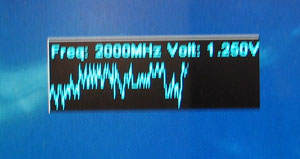
According to Transmeta, the 2.0GHz Efficeon is comparable in overall performance to a 3.0GHz Pentium 4. The WMV HD decode test does back up Transmeta's claims, but it's still a tough pill to swallow given Transmeta's prior performance history.
Transmeta had a Sharp ultraportable on display that was also quite impressive:

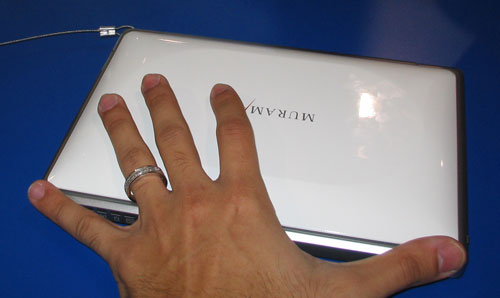
The notebook is extremely tiny but has a keyboard that is barely manageable if you have small hands. But if you've got average sized hands then you'll find yourself cramped for space and if you have big hands then this is definitely not the notebook for you.
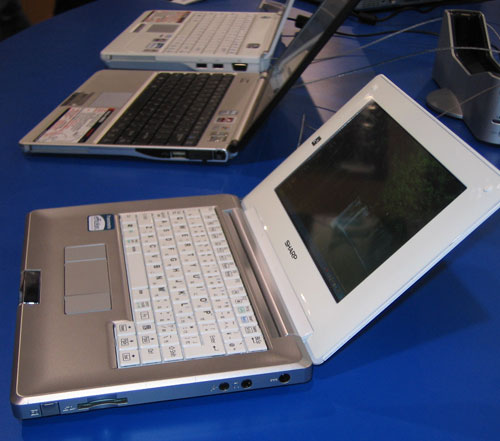
The screen itself is pretty small and it can be hard to read the default sized text in Windows:
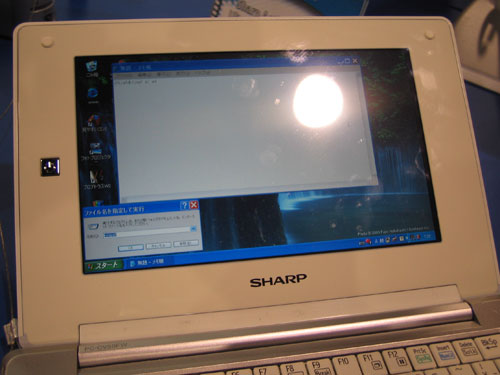
But you can't beat the portability of the notebook, something that Intel has come close to doing with the Pentium M but most of those designs end up being far too conservative compared to what we've seen from the Transmeta camp:

There was an Efficeon media center based platform at the Transmeta booth as well, but it ran MythTV and not XP Media Center Edition. We are curious to see if the Efficeon performs well enough to run a MCE PC as smoothly as some of the higher end AMD and Intel offerings.










48 Comments
View All Comments
sprockkets - Monday, January 10, 2005 - link
Forget using a DLP television, I want a DLP projector on a 100"+ screen.Oh well each has its advantages and disadvantages.
Better not have any stationary images on a plasma I've heard :)
snorre - Monday, January 10, 2005 - link
#23: Well, so you're telling me that the Inquirer are deceiving us then whey reported the following less then a month ago:http://www.theinquirer.net/?article=20211
"The good news for all of you Sound Storm 2 supporters is that Nvidia decided to get this audio back. It just prematurely announced it, as it will take Nvidia at least nine months to put it back to Southbridge. The decision has been made.
Soundstorm 2 will come back but not before roughly the "fall" of 2005."
AtaStrumf - Monday, January 10, 2005 - link
To my displeasure ATi has managed to get at least one product with their new RS300 chipset for Intel out the door. It's called:SHUTTLE ST62K ZEN Barebone
It's could have been a fine product IF only they made it a little bigger so they could put in a PSU, which would enable them to power a graphics card in which case they would actually put in an AGP slot, which they didn't, hence it's a freakin' dead end machine if a word 3D games is in your vocabulary. The on-board 9100 IGP isn't as horrible as I feared, but it sure isn't what you would want to be stuck with, especially at that price.
Why the hell get that thing them? Why not just get a laptop instead?!?!
Do these people even think when designing such products?!?!
Enough ranting.
bob661 - Monday, January 10, 2005 - link
#24It ain't happening. SS is dead and long gone. Accept it. Wallow in it. Order out for more.
Richthofen - Monday, January 10, 2005 - link
#23well The Nvidia CEO seems to tell a different story at least during the last conference call :)
I don't believe for a second either that Nvidia is out of the sound business. They are out of that business right now but that doesn't have to be the case in the future.
I would expect a comeback from them in the sound business once they have made a big step into the Intel chipset business or when they manage to combine sound technology with GPU technology.
Reflex - Monday, January 10, 2005 - link
#9: This has been confirmed multiple times for months now. In fact, the SoundStorm team was completely disbanded before the release of NF3 almost two years ago.I have stated it multiple times, its been both officially and unofficially confirmed before as well. I work for a large software company that has extensive dealings with nVidia. Specifically I work in the audio group, and believe me, the nVidia guys are long gone.
You don't have to believe it, but we are now two chipsets past the last SS enabled one and a lot of people don't quite get it that SS is dead and buried. Will they continue to post about it when the nForce9 is released..?
thraxes - Monday, January 10, 2005 - link
#14While technically correct that the gases in Plasmas wear out with extended use, the effect is hardly noticeable.
I work in a TV studio where we use Pioneer Plasmas and professional grade Barco DLP-RP monitors. The Barcos and the Pioneers have both been in almost continuos use for at least 8-12 hrs every day since 2001. Guess what: The Plasmas are still way way brighter than the DLPs. In fact, the DLPs are probably going to be replaced soon by... plasmas.
Reasons:
1: Brightness - especially when the DLPs are visible on Camera and need to show graphs etc. they are very lacking. Plasmas are bright enough for this and more importantly - camera angle independent. This is even after running them 12 hrs/day for 4 years.
2: Cost of ownership. Run these machines over 12 hours a day EVERY DAY and the money starts to add up. The DLPs are slightly less expensive to buy but need the lamp replaced every few months which is comes to a significant amount of money over the lifetime of the unit. Energy consumption of DLP vs. Plasma is identical at about 400W. The DLP loses out because of your perceived advantage of "just changing the light bulb".
Phantronius - Monday, January 10, 2005 - link
Grrrr no PCI express cards till mid time this year? WTF is this?SunLord - Monday, January 10, 2005 - link
This is amusing but do we have any proof it was a dualcore and not just a dual system they called a dual core?thraxes - Monday, January 10, 2005 - link